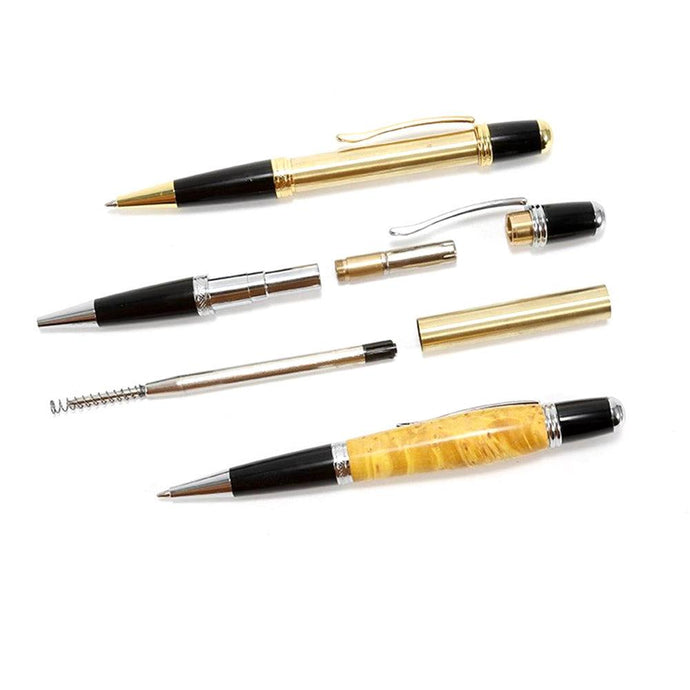In the world of woodworkingg, pen turning has emerged as a cherished niche, combining artistry with precision to create small but exquisite pieces. This craft, which transforms simple cylindrical blanks into intricately detailed writing instruments, relies heavily on a specialized set of lathe tools. These tools, each meticulously designed for specific tasks, are the key to achieving the flawless finish and intricate details that characterize high-quality pens.
At the core of pen turning is the lathe, an essential piece of equipment that holds the pen blank in place while it spins. The lathe allows the woodturner to shape the blank with precision, but its effectiveness is closely tied to the tools used. Pen turning lathes are generally smaller and more compact than their larger counterparts, making them ideal for the detailed work required in pen crafting.
The first and perhaps most versatile tool in a pen turner's toolkit is the roughing gouge. As its name suggests, the roughing gouge is used to remove excess material quickly and shape the pen blank into a rough cylinder. Its curved blade makes it effective for cutting away large amounts of wood, turning a square blank into a rounded form. The roughing gouge sets the stage for more detailed work, creating a smooth, uniform surface that can be further refined.
Following the initial shaping, the spindle gouge comes into play. This tool is particularly useful for adding finer details and shaping the pen's contours. With its more delicate curve compared to the roughing gouge, the spindle gouge excels in creating smooth, intricate profiles and can help in achieving the subtle tapering and curves that define many pen designs. Mastery of the spindle gouge requires a delicate touch and an understanding of the grain direction, as it is essential for creating consistent and smooth cuts.
Another crucial tool is the parting tool, which is used to define and separate sections of the pen blank. The parting tool's narrow, straight blade allows for precise cuts and the creation of clean lines, essential for separating different segments of a pen or defining the transition between the pen's body and the nib or cap. It is indispensable for achieving the sharp, clean transitions that enhance the pen's overall design.
The skew chisel is another important tool in pen turning, valued for its ability to create smooth, flat surfaces and fine details. Its angled edge can produce exceptionally clean and precise cuts, making it ideal for refining the pen's surface and adding intricate touches. However, the skew chisel requires a high level of skill and control, as it is prone to catching or digging into the wood if not used properly. Mastery of the skew chisel can significantly elevate the quality of a pen's finish.
A key component of pen turning is the use of sanding tools to achieve a smooth and polished surface. After the initial shaping and detailing are complete, the pen blank often requires sanding to remove tool marks and imperfections. Sanding pads or abrasive papers, used in progressively finer grits, help to refine the surface and prepare it for finishing. The goal is to achieve a flawless surface that will showcase the beauty of the wood and the craftsmanship of the pen turner.
In addition to these primary tools, various specialized tools can enhance the pen turning process. For example, a caliper or micrometer is invaluable for measuring and ensuring precise dimensions, especially when creating pens with intricate fittings or components. Additionally, specialized turning tools, such as those designed for working with specific materials like acrylics or resin, can expand the creative possibilities and allow for more diverse pen designs.
The art of pen turning is as much about the tools as it is about the craft itself. Each tool plays a distinct role in shaping, detailing, and finishing the pen, and understanding how to use them effectively is crucial for achieving professional-quality results. The combination of these tools, along with the skill and creativity of the woodturner, results in pens that are not only functional writing instruments but also works of art.
Crafting a pen involves a delicate balance of technique and artistry. The tools used in pen turning are designed to offer both precision and versatility, allowing the turner to create pens that are not only aesthetically pleasing but also functional and durable. As pen turning continues to evolve, the timeless nature of these tools remains a cornerstone of the craft, ensuring that each pen crafted is a testament to the skill and dedication of the turner.
In essence, pen turning is a celebration of craftsmanship and precision, where the right tools are essential for transforming raw materials into elegant writing instruments. By mastering these essential lathe tools, woodturners can create pens that are not just utilitarian objects but cherished pieces of art that reflect both personal creativity and the rich tradition of woodworking.

High Quality Product
True Flavor & AromaOur products also
have FSSAI license company.Wide range of Product
With Premium Quality